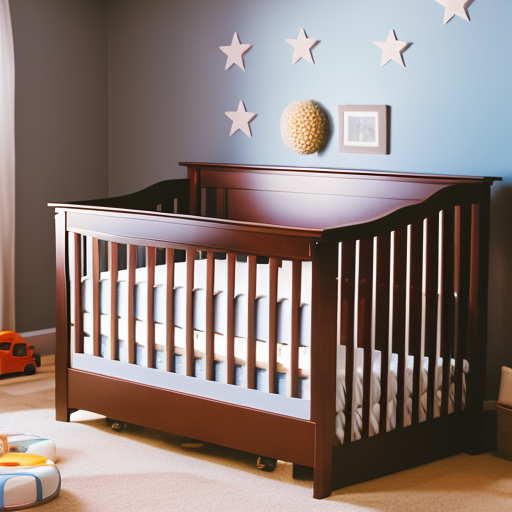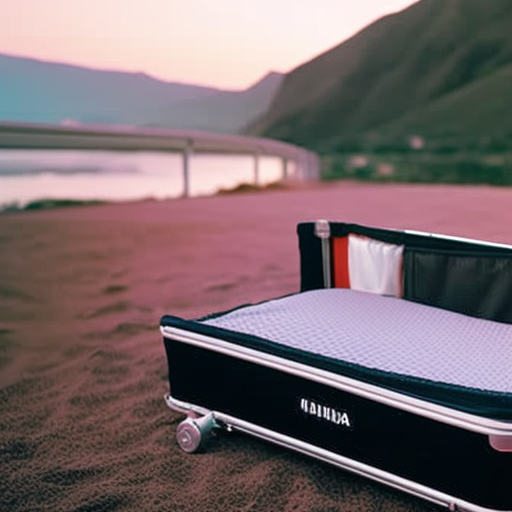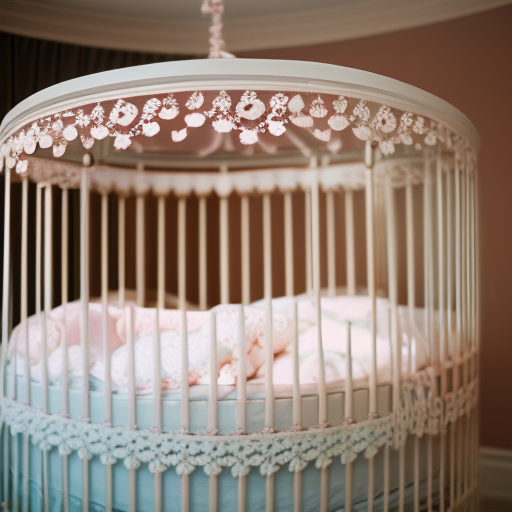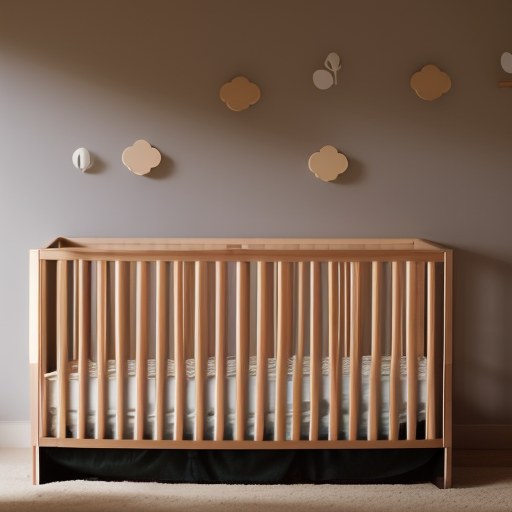"Cherishing Little Steps - A Haven for Baby and Family Journeys"
Types of Cribs
Are you ready to create the perfect sleeping space for your little one? Well, look no further! In this article, we’ll explore the different types of cribs available on the market today.
From traditional cribs to eco-friendly options, we’ve got you covered. We’ll discuss safety standards, features, and benefits of each crib type so that you can make an informed decision.
So let’s dive in and find the crib that will provide comfort and security for your precious bundle of joy!
Key Takeaways
- Traditional cribs are a timeless and classic choice, with popular accessories like mobiles, changing tables, and storage drawers.
- Convertible cribs are versatile and can transition from a crib to a toddler bed and full-size bed, eliminating the need to purchase separate beds as your child grows.
- Portable cribs are convenient for traveling, lightweight, and easy to transport, providing a familiar sleeping environment for your child on-the-go.
- Round cribs add a unique and stylish touch to the nursery decor, are a space-saving option for smaller nurseries or shared rooms, and eliminate sharp edges and corners for increased safety.
Safety Standards for Cribs

Make sure you’re purchasing a crib that meets the latest safety standards.
When it comes to your baby’s safety, there are a few key factors to consider. One important aspect is the firmness of the crib mattress. It’s crucial to choose a mattress that provides proper support for your infant’s growing body. A firm mattress helps reduce the risk of suffocation and Sudden Infant Death Syndrome (SIDS).
When assembling and securing your crib, following proper guidelines is essential for ensuring safety. Start by carefully reading the manufacturer’s instructions before starting assembly. Make sure all components are securely fastened using the recommended hardware provided with the crib. Check that there are no loose or missing screws, bolts, or brackets.
To further enhance safety, avoid placing any soft bedding items such as pillows, blankets, or stuffed animals in the crib with your baby. These can pose suffocation hazards.
Regularly inspect your crib for any signs of wear and tear or damage. Ensure that all parts remain securely in place over time. If you notice any issues or if your child starts to outgrow their crib, it may be time to transition them into a toddler bed.
Traditional Cribs

Take a look at the traditional cribs available for your baby’s nursery. When it comes to choosing a crib for your little one, you want to ensure that it not only meets safety standards but also offers comfort and convenience. Traditional cribs are timeless and classic choices that provide a cozy sleeping space for your baby.
To help you make an informed decision, here is a comparison table highlighting some popular crib accessories and mattress options:
| Crib Accessory | Description | Benefits |
|---|---|---|
| Mobile | Colorful hanging toys | Stimulates visual development |
| Changing Table | Attached surface for diaper changes | Convenient and saves space |
| Storage Drawer | Built-in drawer for extra storage | Keeps essentials within reach |
When it comes to crib mattress options, there are two main types: innerspring mattresses and foam mattresses. Innerspring mattresses have steel coils inside, providing firm support. Foam mattresses, on the other hand, offer lightweight cushioning.
Remember to choose a mattress that fits snugly in the crib with no gaps around the edges to ensure your baby’s safety.
Convertible Cribs

Convertible cribs are a popular choice for parents because they can easily transition from a crib to a toddler bed, and even to a full-size bed as your child grows. This versatility makes them a cost-effective investment that will last for years.
Here are some reasons why convertible cribs are the perfect choice for your growing family:
-
Timeless design: Convertible cribs come in various styles and finishes, ensuring that you can find one to match your nursery decor perfectly.
-
Longevity: With the ability to convert into different bed sizes, convertible cribs eliminate the need for purchasing separate beds as your child gets older.
-
Cost-saving: By investing in a convertible crib, you save money in the long run since you won’t need to buy additional furniture as your child transitions from crib to bed.
When choosing a convertible crib, it’s important to consider factors like mattress support, adjustable height options, and safety features. Additionally, don’t forget about the importance of selecting the right crib mattress and bedding that meets safety standards and provides comfort for your little one.
Overall, convertible cribs offer convenience, longevity, and cost savings while still providing a safe and comfortable sleep environment for your child. Make sure to invest in high-quality crib mattresses and bedding that complement your convertible crib to create an ideal sleeping space for your growing baby.
Portable Cribs

When choosing a portable crib, you’ll appreciate the convenience and flexibility it provides for traveling with your little one. Portable cribs are designed to be lightweight and easy to transport, making them perfect for on-the-go parents. One of the key benefits of using a portable crib is that it allows your child to have a familiar sleeping environment no matter where you are. This can help maintain their sleep routine and ensure they get a good night’s rest even when away from home.
When selecting the best portable crib for your specific needs, there are a few tips to keep in mind. First, consider the size and weight of the crib. You want something that will fit comfortably in your car or travel bag without being too cumbersome. Look for cribs that fold compactly and come with a carrying case for added convenience.
Next, think about the features you need. Some portable cribs come with additional accessories such as bassinets or changing tables, which can be useful if you’re planning on using the crib for an extended period of time or if you want extra functionality while traveling.
Lastly, make sure to check safety ratings and certifications before making your final decision. Look for cribs that meet all current safety standards to ensure your child’s well-being.
Round Cribs

If you’re considering a round crib, you’ll find that it adds a unique and stylish touch to your nursery decor. Round crib designs have become increasingly popular among parents who want to create a modern and elegant look for their baby’s sleeping space.
Here are some benefits of round cribs that make them worth considering:
- Space-saving: Round cribs take up less floor space compared to traditional rectangular cribs, making them ideal for smaller nurseries or shared rooms.
- Safety: Round cribs eliminate sharp edges and corners, reducing the risk of your child getting injured by bumping into them.
- Versatility: Many round cribs come with adjustable mattress heights and convertible features, allowing them to grow with your child from infancy to toddlerhood.
In addition to these advantages, round crib designs offer a visually appealing focal point in the room. They can be customized with various bedding options and accessories to match your desired theme or color scheme.
When choosing a round crib, consider factors such as sturdy construction, non-toxic materials, and ease of assembly. It’s important to prioritize safety features like slat spacing and mattress support.
Eco-friendly Cribs

To make your nursery more environmentally friendly, consider opting for an eco-friendly crib made from sustainable materials. These cribs are designed with the aim of reducing your carbon footprint and promoting a healthier planet for future generations. By choosing a crib made from sustainable materials, you can contribute to the conservation of natural resources and minimize waste.
Many eco-friendly cribs are crafted using sustainable wood, such as bamboo or reclaimed timber. These materials are renewable and have a lower environmental impact compared to traditional hardwoods. Additionally, some manufacturers use non-toxic finishes and adhesives, ensuring that your baby is not exposed to harmful chemicals.
When selecting an eco-friendly crib, look for certifications like FSC (Forest Stewardship Council) or GREENGUARD, which guarantee that the product meets strict environmental standards. Consider features like adjustable mattress height settings and convertible designs that allow the crib to grow with your child, reducing the need for frequent replacements.
Frequently Asked Questions
What Are the Different Types of Crib Mattresses Available and Which One Is the Safest for My Baby?
When it comes to crib mattresses, there are different types available. To ensure your baby’s safety, consider important factors such as firmness, breathability, and materials used. Research and consult experts for the safest option.
Are There Any Specific Safety Guidelines for Choosing Crib Bedding and Accessories?
To ensure your baby’s safety, it is important to follow specific guidelines when choosing crib bedding and accessories. Consider factors like breathability, softness, and proper fit to create a safe sleep environment for your little one.
How Often Should I Inspect and Replace the Crib Hardware to Ensure My Baby’s Safety?
To ensure your baby’s safety, regularly inspect and replace the crib hardware. By doing this, you can prevent accidents and keep the crib sturdy. Stay vigilant and prioritize your little one’s well-being.
Can I Use Secondhand Cribs and What Precautions Should I Take to Ensure They Meet Safety Standards?
When using secondhand cribs, it’s important to take precautions to ensure they meet safety standards. Check for recalls, inspect for damage or missing parts, and use a firm mattress. Consider eco-friendly or budget-friendly crib options as well.
Are There Any Specific Safety Considerations for Cribs Placed in Shared Spaces, Such as Parents’ Bedrooms or Nurseries in Multi-Family Homes?
When it comes to cribs in shared spaces, like your bedroom or a nursery in a multi-family home, safety is crucial. Ensure secondhand cribs meet safety standards and consider spacing, ventilation, and accessibility.
Conclusion
So there you have it, a comprehensive guide to the various types of cribs available in the market.
From traditional cribs to convertible ones, portable options to round designs, and even eco-friendly choices, you now know all about them.
It’s ironic how something as seemingly simple as a crib can have such a wide range of options and safety standards.
But hey, when it comes to your baby’s safety and comfort, it’s always better to be informed and make the right choice.
Happy crib shopping!


